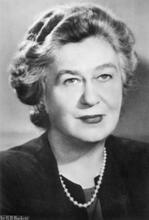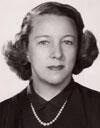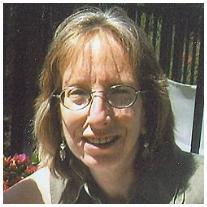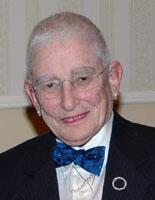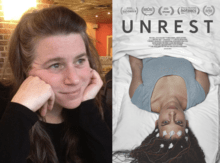Sadie Shapiro
Sadie Shapiro was a leading American-Jewish medical social worker who made pioneering contributions to the field of rehabilitation. For many years, she directed the Social Service Department of the Hospital for Joint Diseases in Manhattan. During World War II, Shapiro helped develop a novel service for wounded soldiers that integrated medical care, rehabilitation, and occupational re-training. Regarded as the nation’s top expert in the field of medical social work, Shapiro was hired in 1946 by the AJJDC as its medical service consultant in Europe and worked for several years in DP camps. In the late 1950s, Shapiro helped launch an on-site retirement service for residents of Morningside Gardens, one of New York City's first racially integrated housing cooperatives. Designed to facilitate aging-in-place, the service continues to serve Morningside residents day.
Early Life and Education
Sadie Shapiro was born on January 17, 1899, in Boston, MA, to Joseph and Margola (Marmor) Shapiro, both immigrants from Lithuania who moved to the United States in the early 1890s. The fourth of five children, she grew up in Chelsea, home to a large Jewish immigrant community. Her father worked variously as a real estate agent and Hebrew teacher while her mother ran a dry goods store. In high school, Shapiro was active in local Zionist youth groups. During her undergraduate years at Boston University in the early 1920s, she was involved in socialist politics on campus, at one point serving as the head of the Boston University chapter of the Intercollegiate Socialist Society.
Shapiro went on to receive a masters degree from the Smith College Training School for Social Work. Her thesis, “A Study of the Personality Traits of the Siblings of Ten Hebrew Dementia Praecox Patients,” completed in 1923, examined the siblings of a group of Jewish patients suffering from a condition now classified as schizophrenia.
Career in Medical Social Work
After finishing her masters degree, Shapiro worked in the Boston area as a case worker for the Federation of Jewish Charities. In 1928, she moved to New York City, where she took courses and taught English language classes at the Rand School of Social Science, a workers’ educational institution with close ties to the Socialist Party of America. In 1931, Shapiro became director of the Social Service Department at the Neurological Institute of New York, a position she held for more than a decade.
In January 1943, Shapiro joined the Hospital for Joint Diseases and Medical Center (today the NYU Langone Orthopedic Hospital) where she spent the rest of her professional career as the director of social services. During the Second World War, Shapiro developed an interest in the relationship between social work and the process of physical and occupational rehabilitation. She quickly garnered a reputation in social work circles as the nation's foremost expert on the subject. In 1943, Shapiro was brought into the activities of the National Council on Rehabilitation. Between 1943 and 1946, she guest lectured at Columbia University in courses on rehabilitation. In the early 1940s, she served as the secretary of the American Association of Medical Social Workers, the field’s leading national organization.
Around this time, Shapiro developed an experimental program for the Hospital for Joint Diseases, which combined medical services, rehabilitation, and occupational re-training under the same roof. Shapiro hoped that this service would increase patients’ likelihood of future occupational success and decrease risk of rehospitalization. The initiative was supported by Fredrick Elton, the New York City Director of the New York State Rehabilitation Service. By October 1944, the Rehabilitation Service was up and running. The New York Post praised it as “one of the newest, most interesting and most worthwhile services going on in the city today.”
Work with Holocaust Survivors in Europe
Shapiro spent the years 1946 to 1948 as a medical social worker in the Displaced Persons camps of postwar Europe. From June 1946 until August 1947, she was employed by the American Jewish Joint Distribution Committee as the organization's medical social work consultant. From September 1947 until November 1948, she worked in Europe under the auspices of the Jewish Agency for Palestine. The AJJDC initially approached her because of her expertise in the process of rehabilitation and her reputation as “the dean in the field of medical social work.”
Shapiro was instrumental in establishing a rehabilitation program for Holocaust survivors in the DP camps. This initiative was backed by the Jewish Agency, the AJJDC, and World ORT. By early 1948, the Rehabilitation Bureau for Jews in Germany and Austria was operational. In a report submitted to the AJJDC in January 1948, Shapiro defined the Bureau’s goal as “the restoration of the disabled to the fullest physical, social and mental usefulness of which they are capable.” According to historian Ada Schein, the primary motivation underlying the Rehabilitation Bureau was absorption challenges in Palestine, where officials of the Jewish community in Palestine prior to the establishment of the State of Israel. "Old Yishuv" refers to the Jewish community prior to 1882; "New Yishuv" to that following 1882.Yishuv were unable to cope with the many disabled Jewish emigrants entering the country. The problem could be mitigated by starting the process of rehabilitation in Europe.
Involvement with Malben
In late 1949, the AJJDC established an institution in Israel called Malben to assist the Israeli government in caring for the thousands of Jews with physical or mental disabilities who had emigrated to the country. In December 1949, the AJJDC invited Shapiro to move to Israel to work as Malben’s medical welfare director. Though she declined the offer, Shapiro participated in the work of the Recruitment Committee for Social Workers in Israel in late 1950. In the postwar years, she also served on the editorial board of The Jewish Social Service Quarterly, the journal of the National Conference of Jewish Communal Service.
Morningside Retirement and Health Services
In 1957, Morningside Gardens, one of New York’s first racially intergrated housing cooperatives for middle-income families, opened on the Upper West Wide, with Shapiro among its first residents. In the late 1950s, she spearheaded an effort to establish a retirement service for the cooperative’s residents of Morningside Gardens.
Morningside Retirement and Health Services was incorporated in 1966. Shapiro and the other co-founders hoped the service would promote aging in place and mutual aid and would help circumvent the need for retired residents to relocate to nursing homes or other long-term care facilities. They anticipated later “naturally occurring retirement community,” or NORCs, which are government-recognized communities eligible for federal and state funding. Morningside Gardens was among the first in New York to be designated a NORC.
Death
Shapiro never married, nor had children of her own, but she was a constant joy and source of support to her six nephews and nieces, according to her nephew Rabbi Joseph Brodie, Vice President Emeritus of Student Affairs at the Jewish Theological Seminary. When Brodie visited his aunt for the last time, she was in her hospital bed, smoking a cigarette and reading a biography of Soviet leader Nikita Khrushchev. She died shortly after that, on May 1, 1967, at the age of 68.
Selected Works by Sadie Shapiro
“Hospital’s Place In Community Organization” Hospitals: The Journal of the American Hospital Association 12, no.1 (February 1938): 48-50.
with Theodate H. Soule. “Medical Social Service for Selectees.” The Family 23, no. 5 (July 1942): 163-173.
Use of the Social Service Exchange by Medical and Psychiatric Social Workers. New Yor: Community Chests and Councils of America, 1944.
National Council on Rehabilitation. The Processes of Rehabilitation. New York: The Livingston Press, 1947.
Szyfman, Leib and W. Schmidt. “Jewish Health and Medical Work in Europe” The Jewish Social Service Quarterly (June 1, 1949): 423-443.
Louvish, Misha. “Malben.” In Encyclopedia Judaica, 2007, Second Edition, Volume 13, 427.
Schein, Ada. “Medical Rehabilitation of Holocaust Survivors in the DP Camps in Germany.” In Freilegungen. Displaced Persons. Leben im Transit: Überlebende zwischen Repatriierung, Rehabilitation und Neuanfang. Edited by Rebecca Boehling, Susanne Urban and René Bienert. Gottingen: Wallstein Verlag, 2014.
Archival Materials
JDC Archives. 1945-1954 New York Collection and 1945-1954 Geneva Collection.
United Nations Archives. S-1268-0000-0026-00001. American Jewish Joint Distribution Committee - Medical file. 1943-01-01—1949-12-31.
The Lillian & Clarence de la Chapelle Medical Archives. Hospital for Joint Diseases Annual Reports, 1943-1966.
Personal Papers and Records of Rabbi Joseph A. Brodie.





